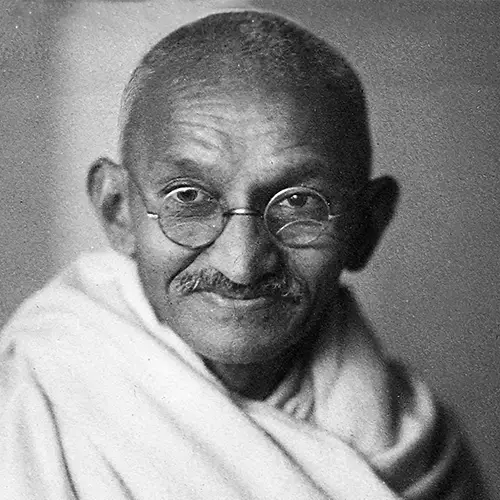Paloceras MicroFactory introduces a new production rhythm to the high-end eyewear industry. Based in Helsinki, the Finnish brand has created a compact manufacturing unit where digital design, advanced 3D printing, and hand finishing come together under one roof. The result is a radically shortened development cycle: what traditionally takes up to twelve months can now […]
Gandhi’s choice of glasses : a symbol in the making
Gandhi began wearing his iconic round glasses in the 1920s, after returning to India following his time living and practicing law in South Africa. These glasses became a symbol of his clear vision for a future free from tyranny and injustice. Gandhi used his glasses to reflect his dedication to the values of simplicity and truth. Their unassuming design perfectly aligned with his belief that true greatness lies in humility.
A clear vision for the future
Gandhi’s glasses symbolize his quiet determination to transform the world through nonviolent means. Their simple and functional design perfectly reflects his commitment to maintaining a clear and steadfast vision of the challenges India faced.
Wearing these glasses also meant being ready to see things as they truly were—without embellishment or illusion. It was a commitment to honesty, to confronting hard truths, and to working tirelessly toward positive change. For Gandhi, having a clear vision meant never losing sight of the goals of the independence movement, even when circumstances seemed discouraging.
A story of simplicity
These glasses also embody Gandhi’s philosophy of simplicity. The frames were rudimentary, often repaired and adjusted over time. This simplicity reflected his commitment to living a life free from material constraints.
“Live simply so that others may simply live,” a quote often attributed to Gandhi (though also to figures like Mother Teresa), captures the essence of his spirit and his dedication to simplicity and fairness. By wearing these glasses, Gandhi sent a clear message: the essence of life lies in commitment and clarity of vision, not in luxury or appearances. This philosophy of simplicity extended far beyond his glasses; it touched every aspect of his life, from his clothing to his public actions.
Constantly repairing his glasses, rather than replacing them with more modern frames, was another way to reject excessive consumption. It underscored his adherence to the principle of Swadeshi—self-sufficiency—emphasizing the importance of using resources wisely and producing goods locally. Each time Gandhi adjusted or repaired his glasses, he reminded his followers that true freedom could only be achieved by letting go of the unnecessary.
While Gandhi wasn’t consciously thinking about environmentalism, his simplicity offers valuable lessons today. In retrospect, it’s clear that such a lifestyle naturally contributes to conserving resources and reducing environmental impact.

Gandhi’s glasses as a cultural icon
Today, Gandhi’s glasses have become a true cultural icon. They are often reimagined in fashion collections, featured in films depicting his life, and evoke the strength of his moral leadership. In a world where complexity and excess are the norm, these glasses remain a symbol of simplicity and clarity. Gandhi not only shaped India’s history but also left behind symbols that continue to inspire generations, with his glasses being among the most recognizable.
A legacy of peace and rebellion
The controversy surrounding Gandhi’s legacy in recent years
In recent years, the figure of Mahatma Gandhi has sparked controversy due to certain aspects of his life and writings. Criticism has been raised about his early statements regarding Black people in South Africa, as well as his positions on caste issues in India.
While Gandhi is often celebrated for his role in India’s fight for independence and his commitment to nonviolence, these aspects of his beliefs have fueled debates about his legacy. Some view him as an imperfect yet transformative figure who evolved and dedicated himself to civil rights and social justice. This controversy highlights the complexity of historical figures and the importance of examining their legacies from multiple perspectives.
The contradiction of auctioning Gandhi’s glasses
The auctioning of Gandhi’s glasses presents an intriguing contradiction between his philosophy and the very nature of the event. Gandhi championed a life of simplicity, rejecting all forms of luxury and unnecessary possessions in favor of absolute minimalism. For him, these glasses were nothing more than a tool, symbolizing his pursuit of truth, clarity, and social justice. Yet, the fact that these glasses were sold at auction for around $340,000 seems completely at odds with the values he upheld.
On one hand, the historical value of these glasses is undeniable—they represent a tangible piece of Gandhi’s legacy, an artifact that offers insight into his life and struggles. Their auction highlights his enduring influence and brings attention to his vision. However, selling them as collectible items at exorbitant prices appears misaligned with Gandhi’s spirit of modesty and equality. This duality serves as a reminder that symbols, even those representing the noblest ideals, can be co-opted by market forces, potentially stripping them of their original meaning.
Despite this contradiction, the auctions have also helped keep Gandhi’s memory alive by bringing his personal items to a global audience. In some cases, the proceeds from these sales have been used for philanthropic purposes, supporting initiatives aligned with Gandhi’s values. These include efforts to improve education in disadvantaged communities, rural healthcare programs, and campaigns promoting nonviolence. In this way, the auctions have, paradoxically, extended Gandhi’s legacy of social welfare and justice.
John Lennon’s glasses : a symbol of counterculture
Gandhi’s glasses are not the only eyewear to leave a mark on history. John Lennon’s round glasses have also had a profound impact on popular culture. While Gandhi and Lennon were very different individuals, their glasses share a common symbolism: a vision of peace and a quest for truth. Where Gandhi used his glasses to represent the fight against injustice, Lennon wore his as an emblem of counterculture, peace, and creativity.
Lennon’s glasses came to symbolize rebellion against established conventions—a way of challenging societal expectations and norms. While Gandhi used nonviolence to dismantle an empire, Lennon wielded music and artistic protest to fight against war and social injustice. Both figures, through their appearance and message, turned a simple object into a powerful tool of communication, representing ideals that transcended their individual lives.
These two icons demonstrate how an everyday accessory can transcend its practical function to become a potent symbol of social transformation. Lennon’s glasses, much like Gandhi’s, continue to be reinterpreted and celebrated by new generations, inspiring cultural movements that share the pursuit of justice, peace, and change.
Beyond the symbol : a vision that endures
Gandhi’s glasses continue to inspire millions of people around the world, proving that even the simplest objects can carry profound ideas. These glasses embody perseverance, humility, and a vision for a more just and equitable humanity. Gandhi demonstrated that truth and clarity were the most powerful weapons against oppression, and his glasses remain the most eloquent visual testament to this philosophy.
Even today, Gandhi’s glasses serve as a powerful metaphor for moral and ethical vision. They are displayed in museums such as the Mani Bhavan Gandhi Museum in Mumbai and the National Gandhi Museum in New Delhi, studied in universities, and frequently referenced in discussions about leadership and integrity. They remind us that vision isn’t just about what we see, but about how we choose to view the world. For Gandhi, vision was also about action: seeing injustice and acting against it, witnessing suffering and striving to alleviate it.
Ultimately, Gandhi’s glasses remind us that the ability to see clearly is an essential prerequisite for acting justly. They symbolize a call to lucidity and commitment, underscoring that even the smallest actions can contribute to profound change.



















